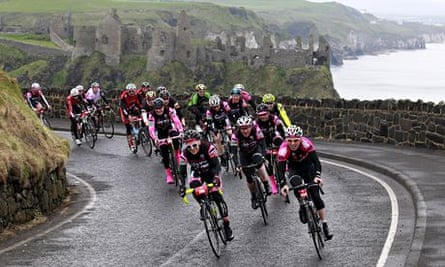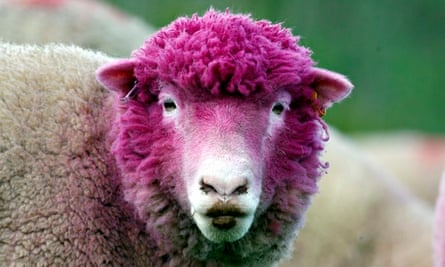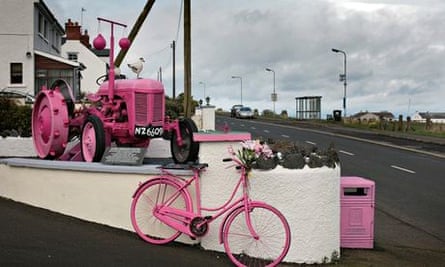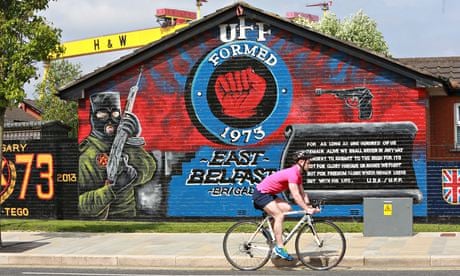It takes a few hours to massage it in, says Sandra Hunter, because wool naturally wants to repel liquid not absorb it, and what is true for rainwater holds equally true for a mixture of beetroot juice and shocking pink hair dye administered from a watering can.
In the field beside her, on her farm next to the Giant's Causeway at the northernmost tip of Northern Ireland, are five cerise pink Wicklow Cheviot ewes and five cerise pink lambs. What do the sheep make of it? "They're happy enough. I think they must be colourblind; they don't even notice."
On Saturday, more than 200 elite cyclists and a caravan of support vehicles, promotional floats and media will whizz along the road just behind the farm as part of the second stage of the Giro d'Italia, one of the most illustrious Grand Tour road racing events, and Hunter was determined to mark the event. The leader of the race wears a pink jersey, and so Hunter's ewes, selected from her flock of 350 because they were already well bonded with their lambs, had to be pink, too.
"The Giro has never been here before and it's a big thing for us," says Hunter who, as well as running two family farms, sits on the local Moyle district council. "The people who are going to come will be buying our milk and our beef, but they are also part of our future. It will help the tourist industry, which will in turn help us farmers. And isn't it fantastic for once to be celebrating something that isn't political?"

Every second year, the organisers of the Giro d'Italia take their Grande Partenza, or Big Start, overseas, and this year it's Northern Ireland's turn. Never can a nation have been more grateful. Gerry Adams's arrest last week in connection to a notorious Troubles-era murder may have convulsed the media and political establishment, but for weeks now, in parts of the province, conversation has focused around "the Giro" and how best to prepare for it.
In Ballyhackamore, east Belfast, past which the riders will pedal twice on Friday evening's opening time trial event, several cafes, the hairdresser, optician's and even surveyor's office have pink window displays declaring "Benvenuti". The village of Bushmills, on the coastal route for Stage 2 on Saturday, has been festooned with pink bunting and chequered pink flags, while the village butcher has painted a cyclist on its window being chased by one of its home-bred Charolais bulls, which you can buy inside ready-filleted.
The cricket club in Armagh, through which the race will pass on Sunday's cross-border Stage 3, finishing in Dublin, has been given permission from the Northern Cricket Union to play in pink, rather than the regulation white. (The city's Catholic and Protestant cathedrals have also joined in moving their Sunday morning services to accommodate the race.)
Schools and churches have been festooned with ribbons, monuments have been painted pink, public buildings from Belfast city hall to Carrickfergus's Norman castle to the Ulster Museum will be illuminated with pink projections. At one point, there was even talk of Kilroot power station, situated on the mouth of Belfast lough and along the race route, belching out pink smoke, according to the local assembly member Alastair Ross.
Yorkshire may be hosting the start of the Tour de France in June, but that county already has its dales, its Brontës and, in York, the second-most popular city in England for tourists.

For Northern Ireland, still struggling to establish a post-Troubles identity 16 years after the Good Friday Agreement, a cycling race broadcast to 165 countries (and a potential audience of up to 800 million people) is a very big deal indeed – even if, with Bradley Wiggins, Chris Froome and Mark Cavendish giving the Giro a miss in favour of the Tour de France, only a tiny proportion of spectators will be able to name a single competitor.
"This is the biggest event we have ever had in Northern Ireland," says Ross who, as private secretary to Arlene Foster, the province's trade and investment minister, was part of the initial delegation that travelled to Italy in 2012 to woo race organisers RCS Sport.
Last year's G8 conference, held in County Fermanagh, brought the world's news media to the province, "but it wasn't something that local people got involved in,and it wasn't something everyone would necessarily be near. This race covers so much of Northern Ireland geographically and allows so many people to interact with it."
The Northern Ireland government paid £3m for the right to host the event, says Ross, and committed to a promotional campaign to support it. "But already in terms of publicity we have had more than 10 times that in return."
But for all the enthusiasm, this is a part of the world where even the most carnivalesque parade has a capacity to turn political. There was early discontent when the race route was announced when it became apparent that while (mostly Protestant) east Belfast was well served, much of (mostly Catholic) west Belfast would be bypassed by the riders. "What we will see is all other parts of the city being touched and being seen worldwide except west Belfast, and it is just not good enough," said local Sinn Féin MP Paul Maskey.
Representatives from south Down, also a majority Catholic area, were similarly aggrieved that the race would bypass the Mourne mountain area.
Ross says the final decision on the route was taken by RCS Sport – it was their decision, for instance, to take the time trial up the steep mile-long driveway to the parliament buildings at Stormont – but that "from a tourism point of view we just wanted to make sure our main tourist locations were shown off".

More serious was a bitter dispute over paramilitary murals, several of which will be passed by the riders along the route. Politicians from all parties struck a deal in February to remove campaign posters for the local and European elections from the route, in order to show the province "in the best possible light". But when Anna Lo, an assembly member for the cross-community Alliance party, suggested murals showing masked gunmen could also be painted over, she was met with a furious response that included, from some quarters, vicious racist abuse (Lo was born in Hong Kong and is a longstanding campaigner for ethnic minorities in the province).
East Belfast has an Alliance MP, Naomi Long, but after the party voted with nationalists to stop the union jack being flown every day from Belfast's city hall, sparking protests in December 2012, it is wildly unpopular in the area's loyalist estates. Last Tuesday evening, the party's Newtownards Road constituency office, past which the riders will cycle on Friday, was firebombed. The large pink cycle in the office window on the morning following the attacks was accompanied by panelling over the broken windows and scorch marks.
"The abuse I have got [since the flags protest] is taking a toll," says Lo. "I have a lot of really foul abuse, really degrading abuse online. I have been having threats made against me, picked up by the police. There was also a spent bullet and a photograph of me sent to a Sunday paper. My stand is still the same, that I am not going to be silenced by the bullies, but it is relentless."
She doesn't regret her comments on the murals on the race route, however. "Not at all, no. I stand by it. It's a great occasion for Northern Ireland to showcase what a beautiful place it is and that we have moved past the days of the Troubles. But there is still a small element of people here who are stuck in the past and only really concerned about sectarian politics. Many local people themselves don't like the murals, she says, but fear intimidation if they speak out.
"The first time we heard anything about the Giro was when Anna Lo popped up to say 'We don't want these images of paramilitarism being displayed around the world'," says David Stitt. The former loyalist prisoner who now runs Charter NI, a community organisation promoting education and peacebuilding among working class Protestant communities He condemns the firebombing and abuse directed at Lo, but passionately disagrees with her. "Those murals have been there for 25 years. To us, that's part of our culture. The conflict is part of our history here and you just can't airbrush it away."
As he notes, the murals are themselves a major tourist attraction, even if locals benefit little from the tour buses that frequently pause outside his office window, which is also on the race route.
"The Giro d'Italia coming through here, it's a good start. But it'll showcase in this area the fact that there's no infrastructure here," says Stitt, who claims the tourist and business development at the Titanic quarter, in the east Belfast docklands that were once this area's major employers, have seen millions spent in their area from which local people are effectively locked out. More work needs to be done, he says, to ensure the dividends of the peace process reach the communities that were worst affected by the Troubles.
And yet, despite inevitable bumps in the road, the race's arrival in the province represents progress that would have been unthinkable 15 years ago, according to Ross. After passing the heart of loyalist east Belfast, where the Presbyterian church has hoisted a bright pink cycle at its front window, the riders will race to the Catholic Lower Ormeau Road, passing the memorial to five people shot dead by loyalist paramilitaries in 1992. In the windows of the Hatfield House bar, next door, are two pink bicycles, and the tricolour flags flying from its flagpoles are not Irish, but Italian.

Comments (…)
Sign in or create your Guardian account to join the discussion